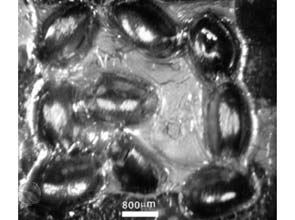Scientists at Pennsylvania State University have drawn inspiration from the eyes of fly-headed fly to improve the efficiency of the next generation of solar cells.
The team is investigating the use of flies' corneas to create biomimetic surfaces or surfaces that mimic the properties of biological tissues. These surfaces can be used for a variety of applications, including solar cells.

The compound eye of the fly head is hemispherical, and the inner surface of the hemispherical compound eye is covered with hexagonal eyes with nanoscale function. Photos from Ashlesh Lakhtakia, Pennsylvania State University
According to researchers, the eyes of fly heads can be used to make solar cells. The compound eye of the fly is hemispherical and the inner surface of the hemispherical compound eye is covered with a hexagonal eye with nanofunction.
"These eyes are the perfect material for making solar cells because they can collect more sunlight from a larger area than just falling on," said Akhalsha Lakhtakia, Professor of Godfrey's Department of Engineering Science and Mechanics in Binder. A plane of light."
However, the surface must maintain a sufficiently fine overall design so that it can be successfully manufactured. Therefore, Mr. Lakhtakia and his colleagues developed a solution to create giant molds that retain nano-functions.
The researchers applied a 250-nanometer nickel coating on the array of nine green fly eyes to fix the cornea on a glass substrate and fill the bottom with polydimethylsiloxane, a silicon-based organic polymer. Nickel will not leak into the eyes behind it.
They then use thermal evaporation to form a coating material in a vacuum chamber, depositing nickel on the surface. The items that receive the coating are attached to a pylon that rotates once every two seconds.
This process will create a 50 mm thick master template that can be used as a mold or as a replica of a pattern stamper. The scientist's goal is to use master templates to further produce other molds and dies, as well as to attach stencils to large-area tile stencils.
The team will expand its template to a cornea containing thirty headed flies. Once they have enough stencils and tile them together, this will create a larger surface for the manufacture of solar cells.